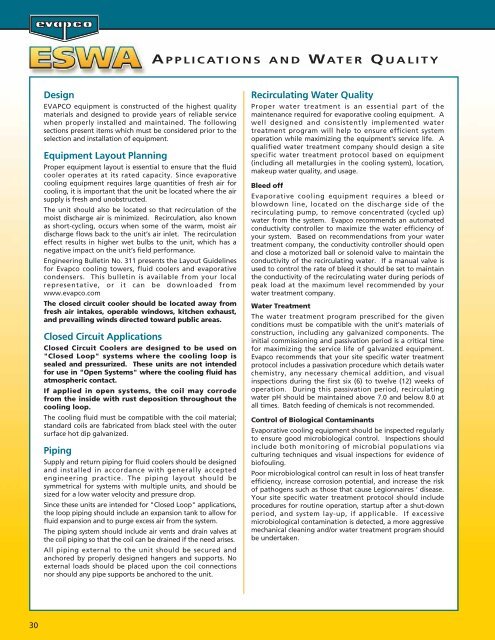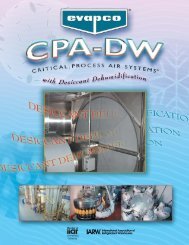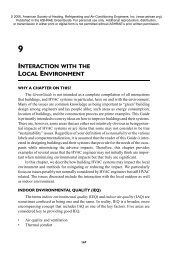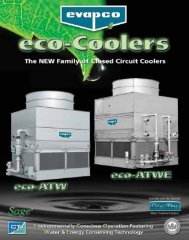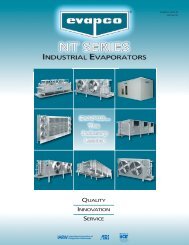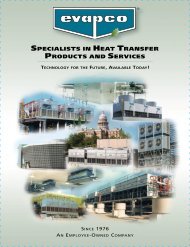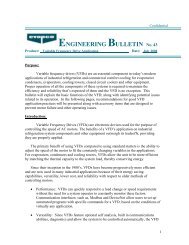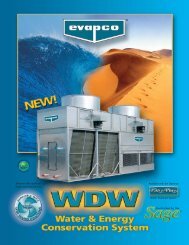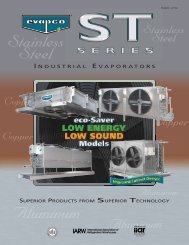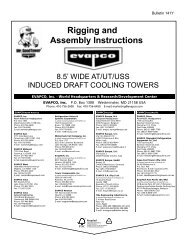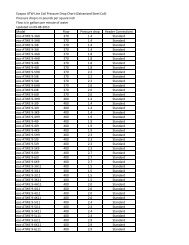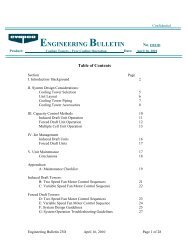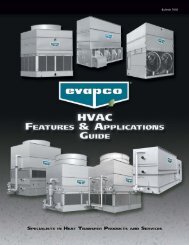ESWA Catalog 241C:ESWA Catalog 241 final copy - EVAPCO.com
ESWA Catalog 241C:ESWA Catalog 241 final copy - EVAPCO.com
ESWA Catalog 241C:ESWA Catalog 241 final copy - EVAPCO.com
Create successful ePaper yourself
Turn your PDF publications into a flip-book with our unique Google optimized e-Paper software.
30<br />
Design<br />
<strong>EVAPCO</strong> equipment is constructed of the highest quality<br />
materials and designed to provide years of reliable service<br />
when properly installed and maintained. The following<br />
sections present items which must be considered prior to the<br />
selection and installation of equipment.<br />
Equipment Layout Planning<br />
Proper equipment layout is essential to ensure that the fluid<br />
cooler operates at its rated capacity. Since evaporative<br />
cooling equipment requires large quantities of fresh air for<br />
cooling, it is important that the unit be located where the air<br />
supply is fresh and unobstructed.<br />
The unit should also be located so that recirculation of the<br />
moist discharge air is minimized. Recirculation, also known<br />
as short-cycling, occurs when some of the warm, moist air<br />
discharge flows back to the unit’s air inlet. The recirculation<br />
effect results in higher wet bulbs to the unit, which has a<br />
negative impact on the unit’s field performance.<br />
Engineering Bulletin No. 311 presents the Layout Guidelines<br />
for Evapco cooling towers, fluid coolers and evaporative<br />
condensers. This bulletin is available from your local<br />
representative, or it can be downloaded from<br />
www.evapco.<strong>com</strong><br />
The closed circuit cooler should be located away from<br />
fresh air intakes, operable windows, kitchen exhaust,<br />
and prevailing winds directed toward public areas.<br />
Closed Circuit Applications<br />
Closed Circuit Coolers are designed to be used on<br />
"Closed Loop" systems where the cooling loop is<br />
sealed and pressurized. These units are not intended<br />
for use in "Open Systems" where the cooling fluid has<br />
atmospheric contact.<br />
If applied in open systems, the coil may corrode<br />
from the inside with rust deposition throughout the<br />
cooling loop.<br />
The cooling fluid must be <strong>com</strong>patible with the coil material;<br />
standard coils are fabricated from black steel with the outer<br />
surface hot dip galvanized.<br />
Piping<br />
Supply and return piping for fluid coolers should be designed<br />
and installed in accordance with generally accepted<br />
engineering practice. The piping layout should be<br />
symmetrical for systems with multiple units, and should be<br />
sized for a low water velocity and pressure drop.<br />
Since these units are intended for "Closed Loop" applications,<br />
the loop piping should include an expansion tank to allow for<br />
fluid expansion and to purge excess air from the system.<br />
The piping system should include air vents and drain valves at<br />
the coil piping so that the coil can be drained if the need arises.<br />
All piping external to the unit should be secured and<br />
anchored by properly designed hangers and supports. No<br />
external loads should be placed upon the coil connections<br />
nor should any pipe supports be anchored to the unit.<br />
A PPLICATIONS AND WATER Q UALITY<br />
Recirculating Water Quality<br />
Proper water treatment is an essential part of the<br />
maintenance required for evaporative cooling equipment. A<br />
well designed and consistently implemented water<br />
treatment program will help to ensure efficient system<br />
operation while maximizing the equipment’s service life. A<br />
qualified water treatment <strong>com</strong>pany should design a site<br />
specific water treatment protocol based on equipment<br />
(including all metallurgies in the cooling system), location,<br />
makeup water quality, and usage.<br />
Bleed off<br />
Evaporative cooling equipment requires a bleed or<br />
blowdown line, located on the discharge side of the<br />
recirculating pump, to remove concentrated (cycled up)<br />
water from the system. Evapco re<strong>com</strong>mends an automated<br />
conductivity controller to maximize the water efficiency of<br />
your system. Based on re<strong>com</strong>mendations from your water<br />
treatment <strong>com</strong>pany, the conductivity controller should open<br />
and close a motorized ball or solenoid valve to maintain the<br />
conductivity of the recirculating water. If a manual valve is<br />
used to control the rate of bleed it should be set to maintain<br />
the conductivity of the recirculating water during periods of<br />
peak load at the maximum level re<strong>com</strong>mended by your<br />
water treatment <strong>com</strong>pany.<br />
Water Treatment<br />
The water treatment program prescribed for the given<br />
conditions must be <strong>com</strong>patible with the unit’s materials of<br />
construction, including any galvanized <strong>com</strong>ponents. The<br />
initial <strong>com</strong>missioning and passivation period is a critical time<br />
for maximizing the service life of galvanized equipment.<br />
Evapco re<strong>com</strong>mends that your site specific water treatment<br />
protocol includes a passivation procedure which details water<br />
chemistry, any necessary chemical addition, and visual<br />
inspections during the first six (6) to twelve (12) weeks of<br />
operation. During this passivation period, recirculating<br />
water pH should be maintained above 7.0 and below 8.0 at<br />
all times. Batch feeding of chemicals is not re<strong>com</strong>mended.<br />
Control of Biological Contaminants<br />
Evaporative cooling equipment should be inspected regularly<br />
to ensure good microbiological control. Inspections should<br />
include both monitoring of microbial populations via<br />
culturing techniques and visual inspections for evidence of<br />
biofouling.<br />
Poor microbiological control can result in loss of heat transfer<br />
efficiency, increase corrosion potential, and increase the risk<br />
of pathogens such as those that cause Legionnaires ’ disease.<br />
Your site specific water treatment protocol should include<br />
procedures for routine operation, startup after a shut-down<br />
period, and system lay-up, if applicable. If excessive<br />
microbiological contamination is detected, a more aggressive<br />
mechanical cleaning and/or water treatment program should<br />
be undertaken.


